Battle in Total War: Warhammer 3 isn't just about winning or losing, it's a fight for survival
Blood for the blood god.
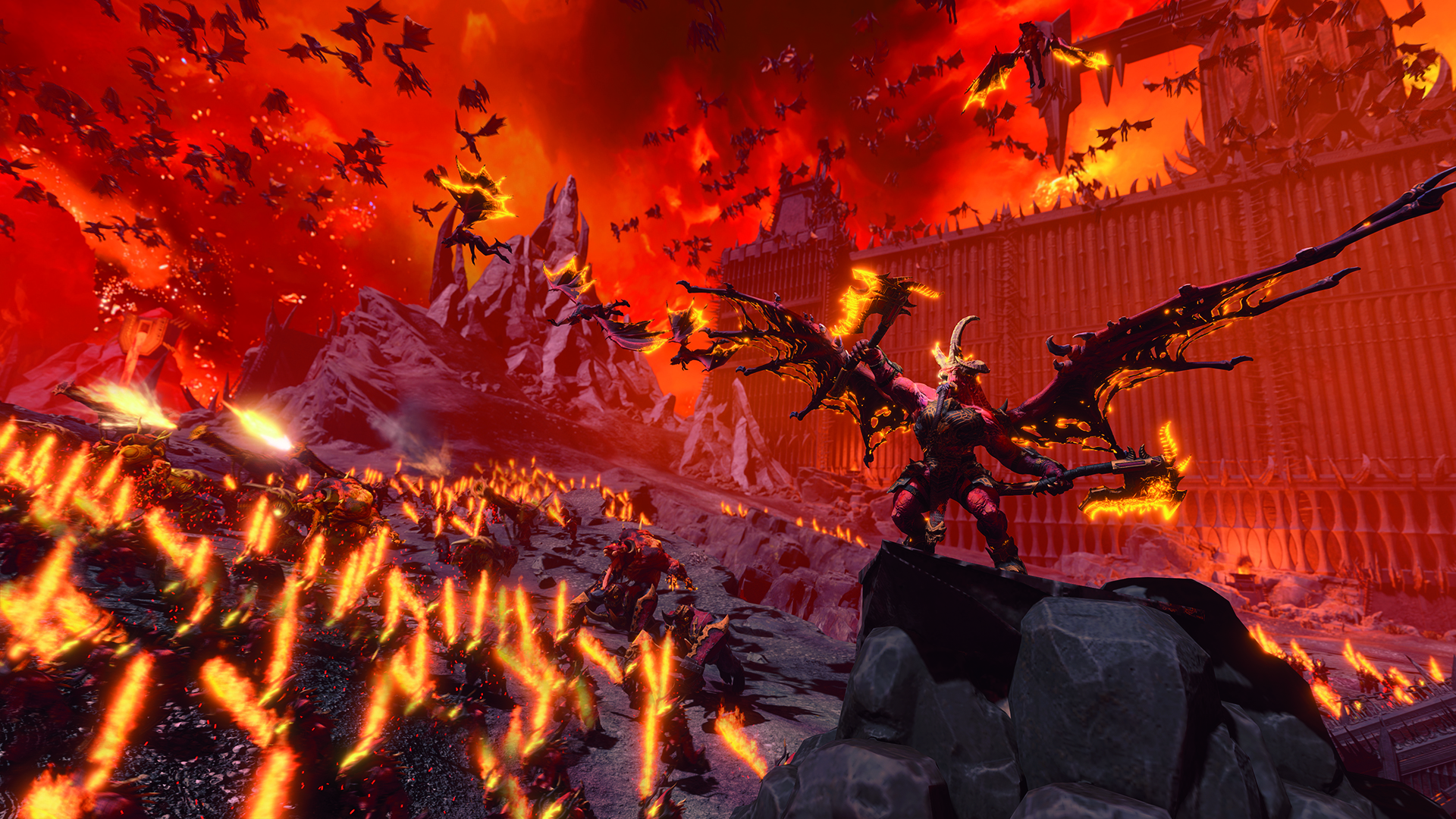
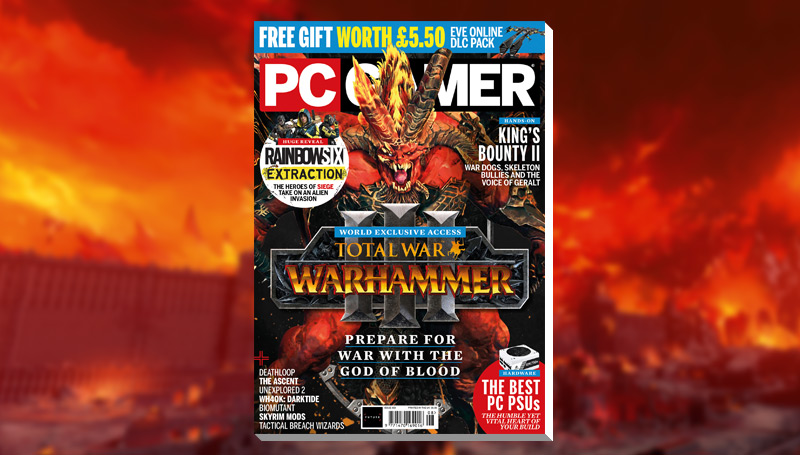
This article first appeared in PC Gamer magazine issue 359 in July 2021. Every month we run exclusive features exploring the world of PC gaming—from behind-the-scenes previews, to incredible community stories, to fascinating interviews, and more.
After five years, we’re nearing the end of our journey through the battlefields of Total War: Warhammer. With the third and final game, we can at last play as and against the daemonic hordes of the Chaos gods, and for this conclusion Creative Assembly still has plenty of tricks up its sleeve. In my first foray into the latest game, I found myself facing an endless horde of these monstrosities, slicing my way through them in a completely new kind of Total War brawl.
Survival battles are an evolution of the quest battles introduced in the previous Warhammer games, where you face a bespoke challenge on an extra fancy map. As the name suggests, you’ll need to deal with relentless waves of enemies as you try to reach your goal – a beefy boss encounter – but thankfully you’ll have a lot of help. Fortifications, reinforcements and buffs can all be summoned by spending supplies, earned through slaughter, giving you more things to manage, yes, but also more ways out of a scrape.
“These are very seminal moments in the narrative arc from the campaign game,” says game director Ian Roxburgh. “They’re all effectively boss battles, where you’ve gone through a chunk of gameplay and this is the final part towards completing that area in the campaign narrative. So they really fit that bill and give it that climactic moment, as well as just providing an awesome opportunity to look at the Chaos Realms in more detail.”
Devilish
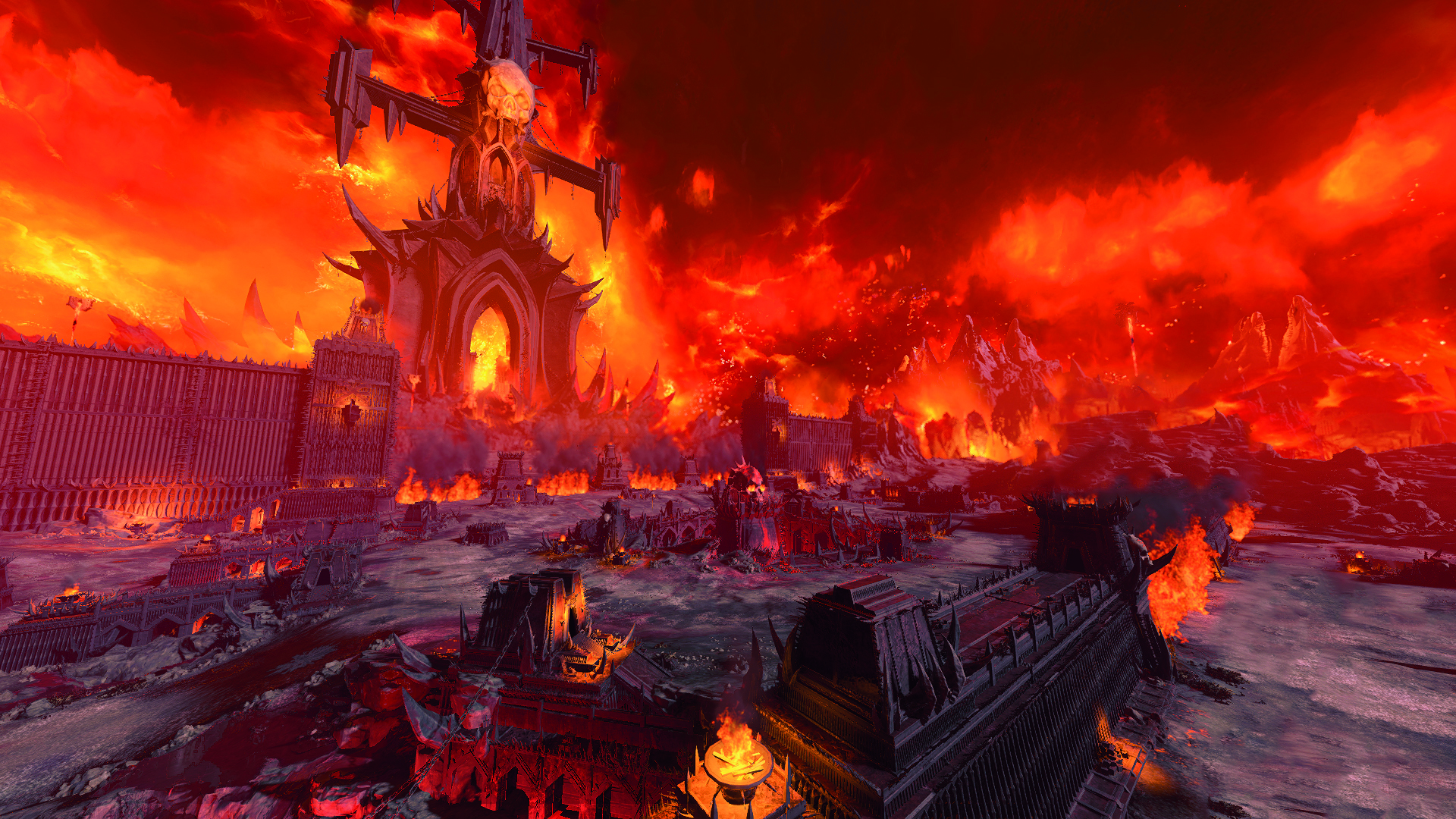
With this survival battle demo comes our first proper look at Creative Assembly’s take on the Realms of Chaos and their denizens, specifically Khorne’s neck of the woods. It’s a burning red hellscape that looks extremely hostile and, as much as terrain can, incredibly angry. This is in keeping with Khorne himself, a bad-tempered boy with a massive rage problem. It’s not the sort of place you’d want to add to your kingdom, but it’s probably the sort of place you’d want to wipe off the map, if you can tackle the daemons trying to stop you.
Warhammer aficionados will recognise these evil, snarling bastards. Bloodletters, Bloodthirsters, Skull Cannons – they’re all here. Battle design lead John Whitson reckons the army really encapsulates the asymmetry that’s come to define this Total War series. “Khorne doesn’t really have many missile options, has no magic at all, because he absolutely scorns the use of magic, but in return his armies have spell resistance innate to them. And really their playstyle is getting into melee combat as quickly as possible, slaughtering the enemy, using that to field powerful army abilities.”
The more they kill, the stronger they get
They’ve got a berserker mentality, and the more they kill, the stronger they get, growing drunk on all the blood and skulls that their god loves so very much. Senior battle designer Oscar Andersson adds that Khorne’s army also contains “probably some of the most elite units available in the game” and by the late game these daemons are going to be pretty deadly. “It’s going to be very tough to beat them because there’s just so much power in each of the Khorne units.” To take them down in battle, you’ll want to hammer them before they can get into melee range, or you’re going to be in a whole heap of trouble.
Army Builder
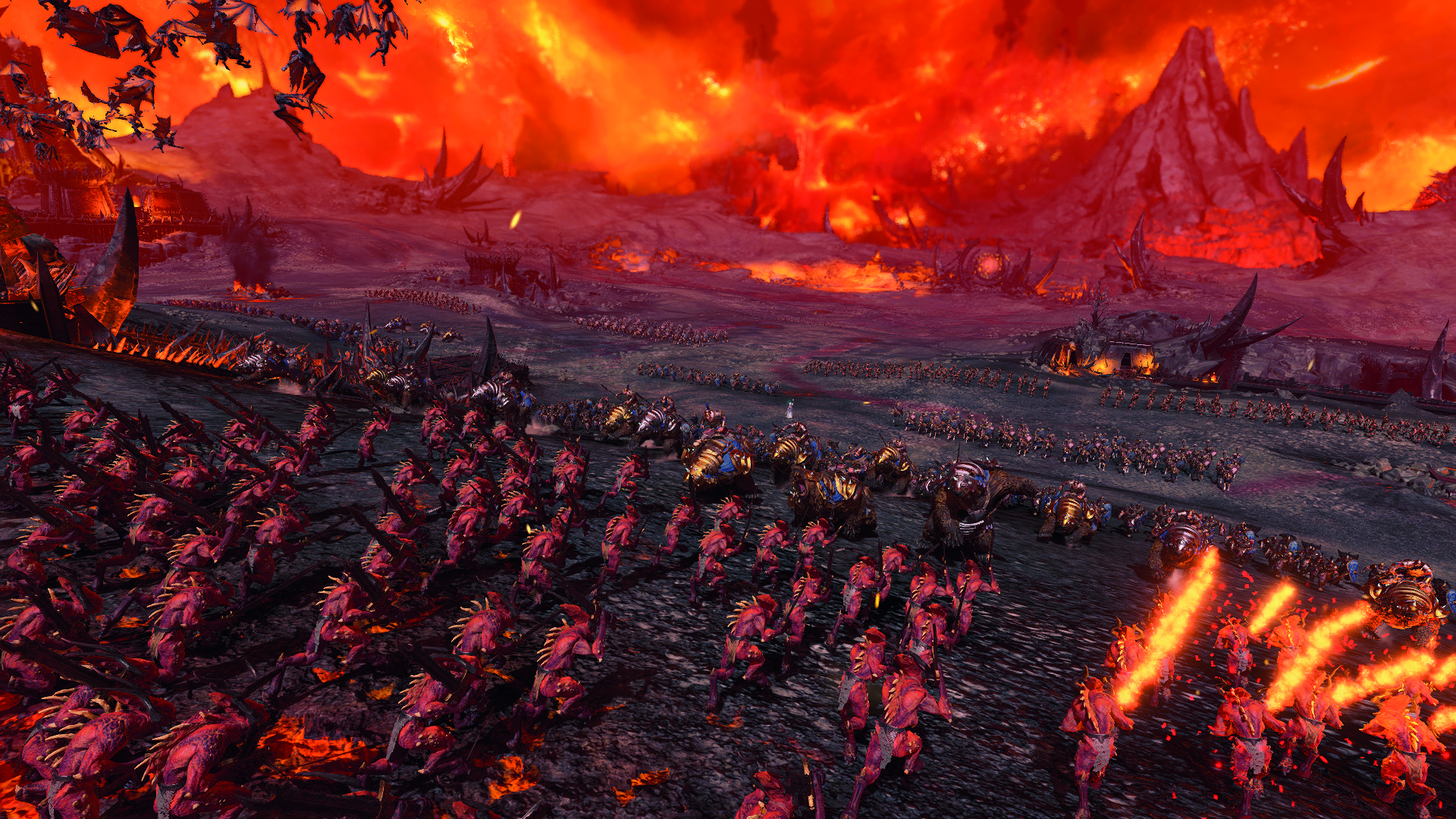
In my own confrontation with them, I had a lot more to worry about than just those berserker daemons. I’ve grown very used to the structure of a Total War battle, but these survival scraps throw a lot of new systems into the mix. It’s still a style of battle that should be very familiar to RTS and tower defence players, however. There are discrete objectives, a simple economy to manage, death-dealing towers to erect, and a battle that feels more like a journey filled with big moments rather than a huge pitched brawl. Doing this in a Total War game is undeniably novel, but it doesn’t feel alien. That makes juggling all the new features a bit easier.
The biggest gaming news, reviews and hardware deals
Keep up to date with the most important stories and the best deals, as picked by the PC Gamer team.
I started off with a small but hardy force of Kislev’s finest, with a mix of ranged, infantry and cavalry units led by Katarin, the Ice Queen of Kislev. It’s an agile, mobile army that is great at harassing the enemy and picking them off. There are some handy hybrid units, too, which can be effective in melee when they’ve run out of ammo or need to deal with daemons who get a bit too close. After taking the first of three capture points, however, I was immediately able to start beefi ng that force up.
“Kislev generally will suit players who enjoy more of a defensive style of play,” says Andersson. “So if you like playing High Elves, I think Kislev will resonate with you quite well. You have very similar elements like you’re very heavy on the skirmish gameplay, and you have a lot of hybrids that are both good at holding their ground, weakening the enemy, and attritioning them as they come in towards you.”
Grin and bear it
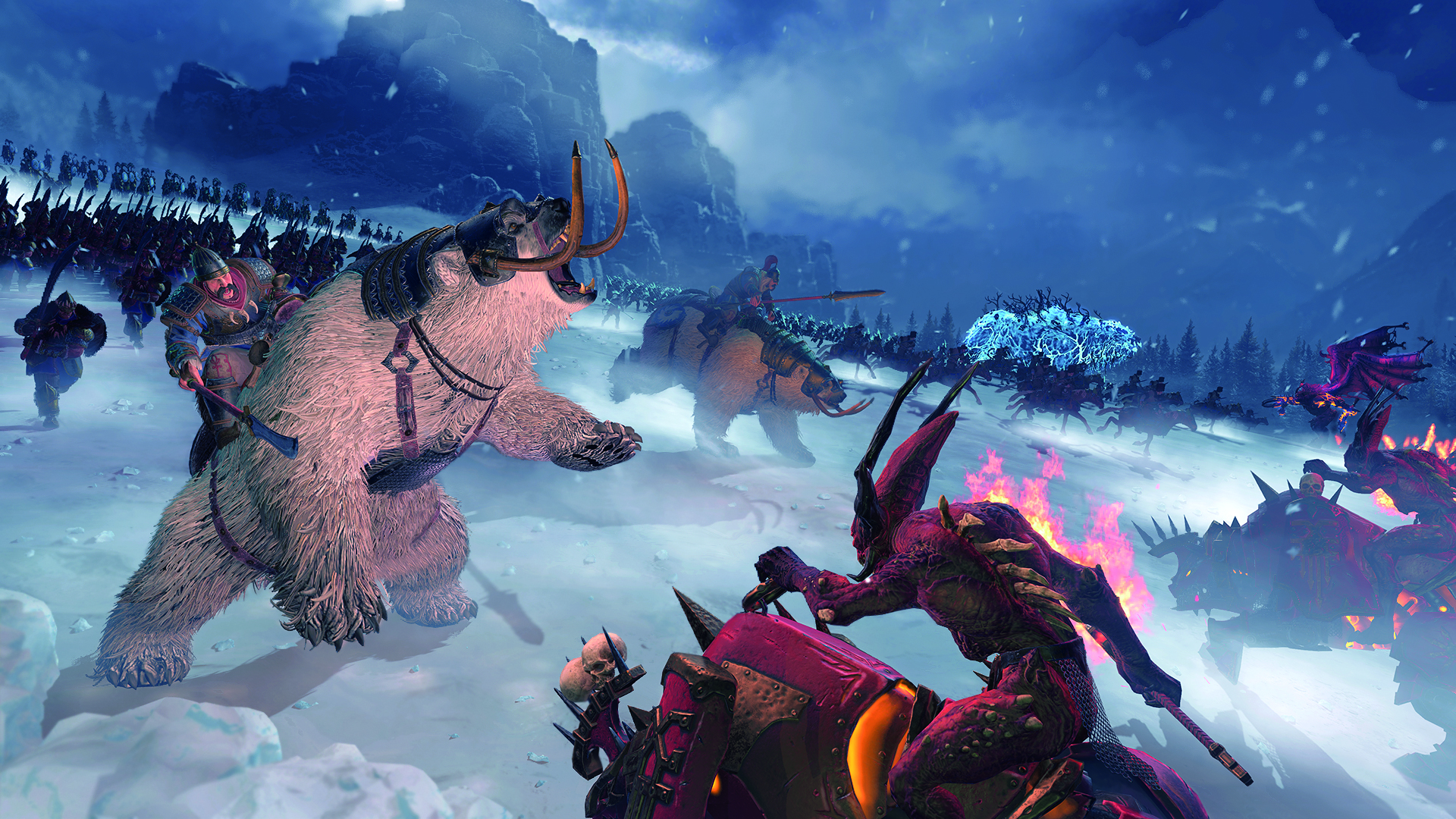
The most important detail, however, has got to be all of those bears. Not only can you field bear cavalry, you can summon huge elemental bears who will merrily squash any daemons in their path. Kislev also has access to a new type of magic, the Lore of Ice, with a range of beneficial and offensive spells. I had a great deal of fun surprising charging enemies with my arcane blizzards.
Survival enemies are weaker than their regular counterparts.
The daemons were still pouring out of portals, so I didn’t have much time to celebrate the capture of the first point or set up my defences. Thankfully, survival battles don’t make you wait around. Recruits are summoned instantly near the capture point, and fortifi cations spring up in a matter of seconds. In moments, I had raised platforms for my archers, indomitable walls, artillery towers, and a bunch of fresh recruits. At this stage only a handful of basic units were available, but otherwise my only limit was my wallet. Fortifications can only be plonked down in specifi c locations, but there are plenty of them. And they’re not just available near the capture points; you can build towers that will pick off a lot of the enemy force long before they arrive.
Even when enemy units made it through my gauntlet of death, my troops made quick work of them. Khorne clearly wasn’t sending his best. I was making plenty of mistakes, some of which I will blame on the fact that I was streaming the demo, which meant I had freezes and fuzzy picture quality to contend with, but none of that stopped Kislev from kicking serious ass. I wish I could say it was all down to skill, but the squishiness of my enemies had a lot to do with it.
Big Softies
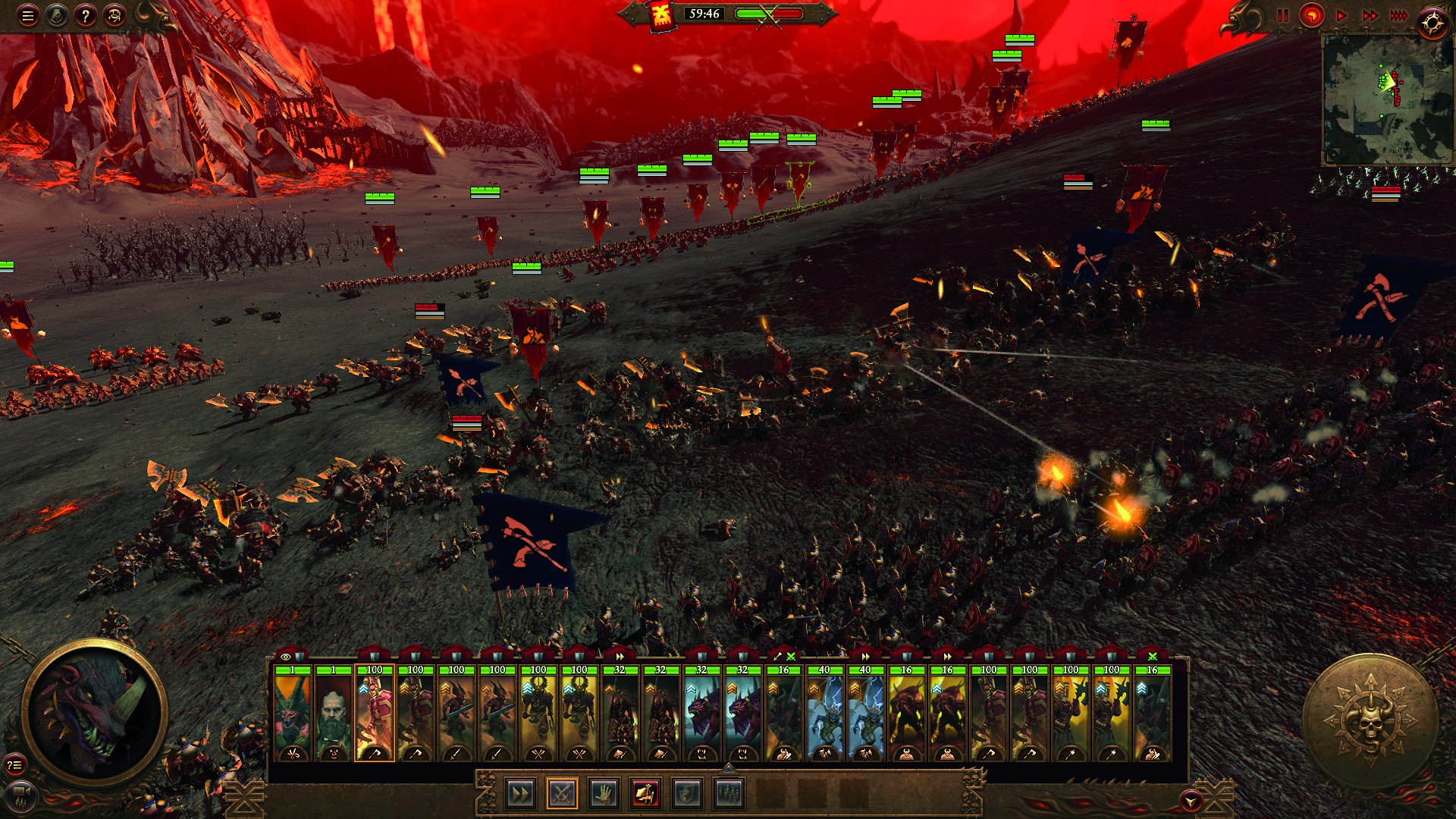
Survival enemies are much weaker than their regular counterparts. “It enables us to create a battle of a much bigger scale than a traditional Total War battle,” says Roxburgh. “So you can create those moments where you’ve got 40 minutes or so of just waves of enemies coming in to really ham it up and create that climactic moment.” And you get to look like a badass, killing the lot of them. The challenge, instead, is managing the in-battle economy and dealing with the relentless tide. That means, even once you’ve moved on to another capture point, you still have to worry about what’s happening behind you. If the enemy takes a point back, you have to go and deal with them, or you won’t be able to summon the boss at the end.
In regular battles, the enemy will be a lot tougher, though smaller in number. But obviously Khorne’s army isn’t unstoppable. Like the undead, daemons have a special morale- adjacent mechanic that means they effectively disintegrate. “With the undead, they crumble when their morale or leadership falls to a certain level,” says Whiston. “With daemons, there’s a similar thing with them for different reasons: that they’re very loosely bound to their physical forms, and particularly to the mortal plane. And when their leadership falls to a certain level, they begin to disintegrate, which you probably saw in that battle.”
Khorne players – and to an extent anyone commanding daemons, since this affects them all – will really need to go in hard at the start of a fight. It’s all about momentum. They need to build up those kills, get as powerful as they can, and not stop until all their enemies are dead. Wasting time will only open them up to the threat of disintegration. Ranged armies, like Kislev or the Wood Elves from the previous games, who they’ll fight in the Mortal Empires campaign, definitely have an advantage against them in this regard, being able to keep them back and pepper them with arrows and even more deadly projectiles. This certainly helped me during my fight, but it still wasn’t a walk in the park.
The Long Game

As survival battles progress, the intensity ramps up, not just because there are more units fighting, but because the units become much more impressive. At the first capture point, you’ll just be recruiting your basic warriors, but by the end you’ll have everything at your disposal, and the same goes for your enemy. You get to make use of all the units and tricks that you’ve learned throughout the campaign, but it still eases you in. This is Total War at its most complex and chaotic, but there’s an underlying structure that makes it feel very manageable indeed.
The time investment and level of micro- management means that these survival battles are a bit tiring, but they’re not common and you won’t come across them randomly. These are fights that you build up to as you kill your way across the campaign map, right up to the doorstep of the Chaos gods. And if you’re playing as one of the daemonic factions, you’ll still have these survival battles when you take the fight to Kislev and Cathay. By making them boss battles that you have to earn, hopefully Creative Assembly will be able to preserve their novelty somewhat.
As survival battles progress, the intensity ramps up.
“We’ve taken the feedback from the previous games,” says Roxburgh, “and a lot of people really like the kind of idea that we introduce more complexity to the endgame mechanics and give you more than just, just conquer, conquer, conquer, to think about, and to link the narrative to that. So with Warhammer III, we’ve just done that even more.” Roxburgh emphasises that this is still a sandbox game where you can conquer to your heart’s content, but there’s also more of a clear story thread for you to follow “a journey into the Chaos Realms” so you’re not merely gobbling up territory. “It’s an even more enhanced version of what we started doing in the Vortex campaign,” he adds.
Mix it up

You’ll also see elements from survival battles cropping up in some other fights, including the new Domination multiplayer mode. “Domination battles are a new exciting way for us to get players started with multiplayer,” says Andersson. “We wanted to shake up the formula of a traditional land battle and give players a chance to bring on reinforcements from their army pool and allow them to react to how the game is unfolding. And you’re also fighting over capture points.”
There’s at least one new battle type in singleplayer, as well, adding minor settlement battles to Warhammer for the first time in the series. These sit between full blown sieges – which are currently also being tinkered with – and regular battles, and will apparently come with their own mechanics, including the ability to tackle the settlement from any angle rather than just a couple of locations.
There are still plenty of unanswered questions, like how the campaign will work now that conquest isn’t the main objective, or how things like diplomacy and the economy will function when you’ve got all these unfriendly daemonic factions. Even with Khorne’s obsession with blood and warfare, he’ll still need some infrastructure to support his goals. With Warhammer III it’s Creative Assembly’s last chance to play with Games Workshop’s grim fantasy universe, at least for now, and it sounds like it’s using this final opportunity to go all out on the experiments. It’s still Total War, but I expect this will be the most unusual one of the lot.

Fraser is the UK online editor and has actually met The Internet in person. With over a decade of experience, he's been around the block a few times, serving as a freelancer, news editor and prolific reviewer. Strategy games have been a 30-year-long obsession, from tiny RTSs to sprawling political sims, and he never turns down the chance to rave about Total War or Crusader Kings. He's also been known to set up shop in the latest MMO and likes to wind down with an endlessly deep, systemic RPG. These days, when he's not editing, he can usually be found writing features that are 1,000 words too long or talking about his dog.

